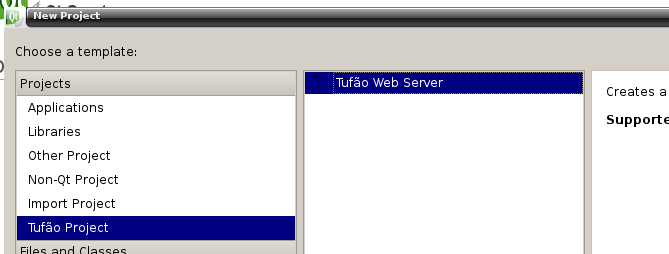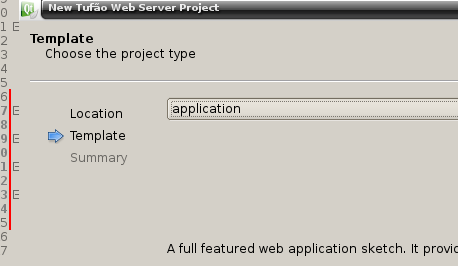|
tufao
1.3.0
An asynchronous web framework for C++ built on top of Qt
|
|
tufao
1.3.0
An asynchronous web framework for C++ built on top of Qt
|
Tufão is a web framework for C++ that makes use of Qt's object communication system (signals & slots). It features:
It uses Ryan Dahl's HTTP parser to provide good performance.
In this section, I assume that you already have installed Tufão libraries and tools (QtCreator's plugin, ...). If you have any trouble following the build/install steps, click here.
Let's start by examining a Hello World application:
The code shown above is what you need to create a program that will respond with Hello World to every request. It depends on QtCore, QtNetwork and Tufão.
In the lines 1-4, we import all definitions we need to this code work and in line 6, we import names from the Tufao namespace into global namespace.
In the function main, we declare our event loop (line 10) that allow us to handle the server's connections asynchronously and in line 22, we start it.
In line 12, we declare the server object, responsible for manage HTTP messages. We can access the HTTP requests through the requestReady signal, as shown in lines 14 to 18. Then, we tell the server to listen for incoming connections on port 8080 (line 20) and our application is ready to serve HTTP clients.
All you need to handle a HTTP session is the pair of HttpServerRequest and HttpServerResponse objects. The HttpServerRequest exports the input of the session and the HttpServerResponse is the output, from the point of view of your application server.
Every HTTP response is made of three parts:
In every response, you must call all these methods, in this order:
The headers are optional and you can set them before do any call to write or – obviously – end. See Tufao::HttpServerResponse for more details.
The handler used as parameter in QObject::connect function is a C++11 lambda, but you can use whatever QObject::connect accepts. In our handler, we just write a simple "Hello World" message.
Now that you got warm, let's see an example more complicated.

First of all, you must open QtCreator and go to the new project dialog, you may be able to select Tufão Web Server project from the list of projects in the Tufão category.

Go through the pages of the project wizard, selecting the application template. At the end, you'll get an unconfigured qmake-based application. Under QtCreator's interface, go to the projects mode and choose a configuration. If you don't configure the project, QtCreator won't be able to compile your project.
You may have a main.cpp file with a code like this:
A main file with 32 lines of code. It's a bunch of code, but they'll prove their value.
Tufão provides a web framework and has its own HTTP server (based on Ryan Dahl's HTTP parser). This design give you greater control over the applications and can really boost its performance. But, as uncle Ben may have told you:
With great power comes great responsibility
This may sound scary to you at first, but don't worry, the Tufão team will do their best to make this responsibility easier to assume, with each realease. But you need to promisse that you'll use Tufão facilities and read the documentation.
To use the Tufão HTTP server, we instantiate, as show in the line 24, a Tufao::HttpServer, put it to listen on port 8080, as show in the line 29, and start a event loop, as show in the line 31. This server will expose all we need to this introduction.
The Tufao::HttpServer will emit the Tufao::HttpServer::requestReady signal each time a request comes. We can handle all requests in a single place in the code, but we won't do that, because... em... as some wise person said before, we need:
What I mean is that every request IS differente and every on needs a different handler. The convention is to serve different content under different paths. This is what we'll do.
We could decompose our slot into some functions to do the job. But we won't do that, because Tufão already has a better abstraction for the problem, Tufao::HttpServerRequestRouter.
The idea behind Tufao::HttpServerRequestRouter is to glue a chain of request handlers and mapped paths to them. If a request comes to a handler unable to handle it, the request is delegated to another handler in the chain.
In the code, we have one router (line 18) and three handlers (lines 16/19, 20 and 21). In line 26-27, we bind the router and the server. The handlers, in order, are:
See Tufão's plugin system to learn how to create and attach plugins to the running application.
If you access http://localhost:8080/ you'll see a message telling you that the page wasn't found. Create a folder called public in the working dir of the executable and put a file called index.html there:
<html>
<head><title>Hello World</title></head>
<body>
<h1>Congratulations,</h1>
<p>you are able to start web development in C++ with Tufão</p>
</body>
</html>
Now access the page http://localhost:8080/index.html and see the result. As an exercise, I left the task to add a favicon to your application using the Tufão's plugin system.
The Tufão has native support to three build systems: qmake, pkgconfig and CMake.
Once Tufão is correctly installed, you can use Tufão in your qmake-based applications appending the following line to your project file, where x is the major version (0 for Tufão 0.x and 1 for Tufão 1.x) you want to use:
CONFIG += TUFAOx
If you use CMake, just follow the common steps (require package and handle compile and link flags) in your CMakeLists.txt file:
find_package(Tufao1 1.0 REQUIRED)
include_directories("${TUFAO_INCLUDE_DIR}")
target_link_libraries(foobar ${TUFAO_LIBRARIES})
If you want to use a FindTufao.cmake file embedded in your project dir, add the following line to your CMakeLists.txt:
set(CMAKE_MODULE_PATH ${CMAKE_MODULE_PATH} "/path/to/FindTufao.cmake")
If you want to use autotools or another build system that has pkgconfig support, you can use the Tufão's pkgconfig module, where x is the major version (0 for Tufão 0.x and 1 for Tufão 1.x) you want to use:
$ pkg-config tufaox
If want to use a build system that don't support pkgconfig, you should be ashamed, but you may still be able to use Tufão (probably editing the compiler -I flag and the linker -L and -l flags).